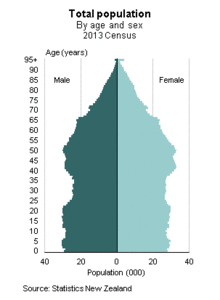Demographics of New Zealand

Population pyramid taken from the 2013 Census
|
|
| Population | 4,693,000 |
|---|---|
| Density | 17.5/km2 (45.3/sq mi) |
| Growth rate | 1.9% |
| Birth rate | 13.27 per 1000 pop. |
| Death rate | 6.87 per 1000 pop. |
| Life expectancy | |
| • male | 79.5 years |
| • female | 83.2 years |
| Fertility rate | 1.99 births per woman |
| Infant mortality rate | 4.11 per 1000 live births |
| Net migration rate | 12.68 per 1000 pop. |
| 0–14 years | 19.9% |
| 15–64 years | 65.4% |
| 65 and over | 14.7% |
| Total | 0.97 males/female |
| Under 15 | 1.05 males/female |
| 15–64 years | 0.96 males/female |
| 65 and over | 0.86 males/female |
| Nationality | New Zealander |
| Major ethnic | European 74.0% |
| Minor ethnic |
|
| Official |
|
The demographics of New Zealand encompass the gender, ethnic, religious, geographic, and economic backgrounds of the 4.7 million people living in New Zealand. New Zealanders, informally known as "Kiwis", predominantly live in urban areas on the North Island. The five largest cities are Auckland (with one-third of the country's population), Christchurch (in the South Island, the largest island of the New Zealand archipelago), Wellington, Hamilton and Tauranga. Few New Zealanders live on New Zealand's smaller islands. Waiheke Island (near Auckland) is easily the most populated smaller island with 9,150 residents, while Great Barrier Island, the Chatham and Pitt Islands and Stewart Island each have populations below 1,000. New Zealand is part of a realm and most people born in the realm's external territories of Tokelau, the Ross Dependency, the Cook Islands and Niue are entitled to New Zealand passports. In 2006, more people who identified themselves with these islands lived in New Zealand than on the Islands themselves.
The majority of New Zealand's population is of European descent (69 percent identify as "New Zealand European"), with the indigenous Māori being the largest minority (14.6 percent), followed by Asians (9.2 percent) and non-Māori Pacific Islanders (6.9 percent). This is reflected in immigration, with most new migrants coming from Britain and Ireland, although the numbers from Asia are increasing. In 2001 an estimated 460,000 New Zealanders lived abroad, mostly in Australia, representing nearly one-quarter of NZ's highly skilled workforce. The largest Māori iwi is Ngapuhi with 122,211 people or 24 percent of the Māori population. Auckland is the most ethnically diverse region in New Zealand with 56.5 percent identifying as Europeans, 18.9 percent as Asian, 11.1 percent as Māori and 14.4 percent as other Pacific Islanders. The ethnicity of the population aged under 18 years is more diverse (72 percent European, 24 percent Māori, 12 percent Pacific and 10 percent Asian) than the population aged 65 years or older (91 percent European, 5 percent Māori, 4 percent Asian and 2 percent Pacific). Recent increases in interracial marriages have resulted in more people identifying with more than one ethnic group.
...
Wikipedia
